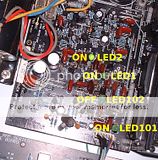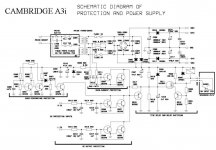I was recently given a Cambridge Audio a3i, as it doesn't work and I thought I could have a go at fixing it instead of binning it... 
Now, I have plugged it up and it won't output anything thru the speakers, no matter which input I use.
I have had it apart, and I've found what maybe the problem, one of the LED's does not light up at all:

If I leave it for a while, LED102 sometimes lights up for less than 1 second, which means the LED itself is ok, but something somewhere isn't.
All of the rest of the LED's light up, and go out slowly when the amp is turned off... I have yet to check the fuses with a multimeter, but they look ok physically (no burnt out wire visible)
I have also yet to check the rails, but I'm guessing they should be +50v and -50v right? Anything else I can do to try and find the fault here?
Now, I have plugged it up and it won't output anything thru the speakers, no matter which input I use.
I have had it apart, and I've found what maybe the problem, one of the LED's does not light up at all:

If I leave it for a while, LED102 sometimes lights up for less than 1 second, which means the LED itself is ok, but something somewhere isn't.
All of the rest of the LED's light up, and go out slowly when the amp is turned off... I have yet to check the fuses with a multimeter, but they look ok physically (no burnt out wire visible)
I have also yet to check the rails, but I'm guessing they should be +50v and -50v right? Anything else I can do to try and find the fault here?
Yep, it definately looks like the power amp is the problem part, there is an led for the pre-amp part, which lights up fine, but isn't in the pic I posted. Now how would I go about checking the semiconductors? There are four huge ones that are screwed to a heatsink, are these the semiconductors I should check? Also, how would I check them? I only have a DMM and access to a scope if needed, but I don't want to break it any more by putting probes in the wrong place. 

I've got one that has a diode test function... The big semiconductors say this on them:
"SanKen
2SA1216
77Y"
And they look like this:
I'm guessing these are the ones I need to test. Now, I'm a bit of a newbie when it comes to power amps, so what exactly do I need to do to test if they are ok? I can test them without unsoldering them can't I?
EDIT: 2 of the big semiconductors are 2SC2922's, and the other two are 2SA1216's.
"SanKen
2SA1216
77Y"
And they look like this:
An externally hosted image should be here but it was not working when we last tested it.
I'm guessing these are the ones I need to test. Now, I'm a bit of a newbie when it comes to power amps, so what exactly do I need to do to test if they are ok? I can test them without unsoldering them can't I?
EDIT: 2 of the big semiconductors are 2SC2922's, and the other two are 2SA1216's.
Progress: All fuses are good. I took them all out and all have resistance of less than 5 ohms.
The coil seems good aswell. I checked the output from the ground of the chassis to the fuses in the power and, and both read 29Vac. I'm using a fluke 23 DMM, so I guess it's probably giving me the RMS value here.
Now, I'm not really sure how to measure the rails. I know the the AC current goes thru the 4 diodes (bridge rectifier) thenthe 10,000uF caps smooth the output to give around 50Vdc.
If I knew where to measure the rail voltage I would, but I don't know where to put the probes.
Also, I've noticed there is an ekectromechanical relay in this circuit, but I don't clear it clicking when the amp gets turned on and off... could the relay be dead? Is it taking it out and maybe testing it out of the circuit?
The coil seems good aswell. I checked the output from the ground of the chassis to the fuses in the power and, and both read 29Vac. I'm using a fluke 23 DMM, so I guess it's probably giving me the RMS value here.
Now, I'm not really sure how to measure the rails. I know the the AC current goes thru the 4 diodes (bridge rectifier) thenthe 10,000uF caps smooth the output to give around 50Vdc.
If I knew where to measure the rail voltage I would, but I don't know where to put the probes.
Also, I've noticed there is an ekectromechanical relay in this circuit, but I don't clear it clicking when the amp gets turned on and off... could the relay be dead? Is it taking it out and maybe testing it out of the circuit?
Oops, forgot to test the speaker outputs.
Left channel - 0.37v when amp is off
Left channel - 0.35v when amp is on with no signal
Left channel - 0.34v when amp is on with with signal
Hmm, I've now turned it off again and it's gone down to 0.30v. Might be a cap slowly discharging? Now for the right:
Right channel - 0.24v when amp is off
Right channel - 0.23v when amp is on with no signal
Right channel - 0.28v when amp is on with with signal
It hopped up to 0.28v when I flipped it to CD input... CD just has music playing at the time. Anything else I can test with the DMM before I start pulling it apart to check the maybe faulty relay?
Left channel - 0.37v when amp is off
Left channel - 0.35v when amp is on with no signal
Left channel - 0.34v when amp is on with with signal
Hmm, I've now turned it off again and it's gone down to 0.30v. Might be a cap slowly discharging? Now for the right:
Right channel - 0.24v when amp is off
Right channel - 0.23v when amp is on with no signal
Right channel - 0.28v when amp is on with with signal
It hopped up to 0.28v when I flipped it to CD input... CD just has music playing at the time. Anything else I can test with the DMM before I start pulling it apart to check the maybe faulty relay?
mike-do your self a favor-bring that amp to some techie around you;
you have lethal voltages inside,and you obviously don't have a clue what is what;
no pun intended-I just remember too well my own beginnings in electronic- happily I wasted gadgets already intended for trash and I didn't electrocuted my self;
you need more studious reading and thinking before putting probes in live circuit
you have lethal voltages inside,and you obviously don't have a clue what is what;
no pun intended-I just remember too well my own beginnings in electronic- happily I wasted gadgets already intended for trash and I didn't electrocuted my self;
you need more studious reading and thinking before putting probes in live circuit
You really need to get a schematic instead of blindly stabbing about. If memory serves the guy who designed these amplifiers for Cambridge visits this board... and may well oblige.
You could try asking Cambridge themselves but more than likely they will tell you to get it serviced by an "authorized repair technician" - ie, Richer Sounds.
The LED's are most likely references for current sources. They should all be well lit, if they're not then the amp isn't going to function. Hopefully, the output devices will be fine. If they aren't, it might not be worth repairing.
You could try asking Cambridge themselves but more than likely they will tell you to get it serviced by an "authorized repair technician" - ie, Richer Sounds.
The LED's are most likely references for current sources. They should all be well lit, if they're not then the amp isn't going to function. Hopefully, the output devices will be fine. If they aren't, it might not be worth repairing.
I would take it to someone who knows more about these sorts of things, but I don't know anyone locally. I'm careful and aware of the dangerous bits in the circuit, and tread carefully when testing things. I make sure nothing is shorting when testing, normally I tinker with computers so I'm all too aware of killing things by being to gung ho with the soldering iron.Zen Mod said:mike-do your self a favor-bring that amp to some techie around you;
you have lethal voltages inside,and you obviously don't have a clue what is what;
no pun intended-I just remember too well my own beginnings in electronic- happily I wasted gadgets already intended for trash and I didn't electrocuted my self;
you need more studious reading and thinking before putting probes in live circuit
Leolabs said:Hi,Mike!Still the same suggestion,measure semiconductors first esp the
small signal transistors.
Ok, I will. I've got a fluke DMM which has diode testing function on it, could you tell me roughly what I need to do to test these semiconductor? Are they like diodes really, and just need to check they are not letting current thru the wrong way? Can I test them in circuit or do they have to be removed/unsoldered?
jaycee said:You really need to get a schematic instead of blindly stabbing about. If memory serves the guy who designed these amplifiers for Cambridge visits this board... and may well oblige.
You could try asking Cambridge themselves but more than likely they will tell you to get it serviced by an "authorized repair technician" - ie, Richer Sounds.
The LED's are most likely references for current sources. They should all be well lit, if they're not then the amp isn't going to function. Hopefully, the output devices will be fine. If they aren't, it might not be worth repairing.
Well, I might take it to richer sounds and see what they say. I've attached a partial schematic, which covers the coil and the protection circuits and the rectifiers mainly. Hopefully the guy who designed this amp might see this... I'll have a search thru some older threads and see if he is still aounrd.
Attachments
x-pro (Alex) is the person you need to ask. He is the designer. 
He may be able to send schematics if you ask nicely. He has been very helpful with me.
He has been very helpful with me.
Do take the amp to be serviced if you are not 100% comfortable with it. Without wishing to insult you, it is always better to be safe than sorry.

Regards,
Carl
He may be able to send schematics if you ask nicely.
Do take the amp to be serviced if you are not 100% comfortable with it. Without wishing to insult you, it is always better to be safe than sorry.

Regards,
Carl
- Status
- This old topic is closed. If you want to reopen this topic, contact a moderator using the "Report Post" button.
- Home
- Amplifiers
- Solid State
- Cambridge A3i... is it dead?
